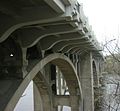Intercity Bridge
The bridge was originally built to service Ford's Twin Cities Assembly Plant, so Minneapolis residents could commute to the Ford plant. The Ford plant, along with Lock and Dam No. 1, was expected to make the Highland Park area of St. Paul extremely desirable. As part of the planned development, St. Paul expanded the original street, Edsel Avenue, and renamed it Ford Parkway. The bridge project was designed by a committee of politicians and engineers from both Minneapolis and St. Paul and chaired by Charles M. Babcock, Minnesota's first commissioner of highways. The development that was expected as a result of the bridge did not materialize, however, because of the Great Depression and growth in Minneapolis neighborhoods on the opposite side of the bridge. It was not until after World War II that the desired growth in the Highland Park area resulted from the bridge.
In 1972-1973, the bridge was redecked and widened, but this did not detract from the historic significance of the bridge. In 2004, the bridge was rebuilt from the arches up. The rebuilding project was given an award by the Minnesota Society of Professional Engineers in 2006.
Pictures
-
A view from the south side, with the powerhouse of the Ford Dam in the foreground.
-
A view from underneath the bridge on the St. Paul side, looking west.
-
Plaque commemorating the construction of the Intercity Bridge on the St. Paul side.
See also
References
- ^ "Minnesota's Historic Bridges - Intercity Bridge". Minnesota's Historic Bridges. Minnesota Historical Society. 1996. Archived from the original on May 7, 2014. Retrieved April 17, 2006.
- ^ Weeks, John (2005). "Intercity Bridge, St. Paul, MN". The Bridges Of Minneapolis And St. Paul. Retrieved April 17, 2006.
- ^ "Minnesota Society of Professional Engineers - Seven Wonders Awards". Minnesota Society of Professional Engineers. 2006. Archived from the original on December 22, 2005. Retrieved April 17, 2006.




